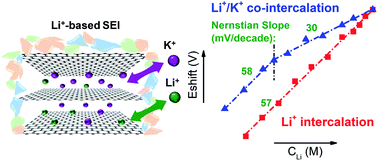Nernstian Li+ intercalation into few-layer graphene and its use for the determination of K+ co-intercalation processes†
Abstract
Alkali ion intercalation is fundamental to battery technologies for a wide spectrum of potential applications that permeate our modern lifestyle, including portable electronics, electric vehicles, and the electric grid. In spite of its importance, the Nernstian nature of the charge transfer process describing lithiation of carbon has not been described previously. Here we use the ultrathin few-layer graphene (FLG) with micron-sized grains as a powerful platform for exploring intercalation and co-intercalation mechanisms of alkali ions with high versatility. Using voltammetric and chronoamperometric methods and bolstered by density functional theory (DFT) calculations, we show the kinetically facile co-intercalation of Li+ and K+ within an ultrathin FLG electrode. While changes in the solution concentration of Li+ lead to a displacement of the staging voltammetric signature with characteristic slopes ca. 54–58 mV per decade, modification of the K+/Li+ ratio in the electrolyte leads to distinct shifts in the voltammetric peaks for (de)intercalation, with a changing slope as low as ca. 30 mV per decade. Bulk ion diffusion coefficients in the carbon host, as measured using the potentiometric intermittent titration technique (PITT) were similarly sensitive to solution composition. DFT results showed that co-intercalation of Li+ and K+ within the same layer in FLG can form thermodynamically favorable systems. Calculated binding energies for co-intercalation systems increased with respect to the area of Li+-only domains and decreased with respect to the concentration of –K–Li– phases. While previous studies of co-intercalation on a graphitic anode typically focus on co-intercalation of solvents and one particular alkali ion, this is to the best of our knowledge the first study elucidating the intercalation behavior of two monovalent alkali ions. This study establishes ultrathin graphitic electrodes as an enabling electroanalytical platform to uncover thermodynamic and kinetic processes of ion intercalation with high versatility.

- This article is part of the themed collection: Editor’s Choice: Zaiping Guo


 Please wait while we load your content...
Please wait while we load your content...